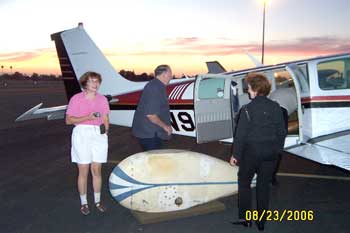
Wiley Post and Harold Gatty next to the Winnie Mae - Photo courtesy of Bob Kemper
I had some foundation work done on the house 3 years ago and everything had to be removed from the basement. It was full of things my mother and father had collected over the last 60 years. I enjoyed going through everything she had saved: our old toys, barrels full of dishes, old clothes, dining room tables, chairs and airplane parts. One piece I distinctly remember was a large metal object that I thought was part of an airplane wing. It came out with everything else and I was ready to take it to the recycle center but I decided to put it in the garage with everything else I was saving. If my parents had held onto it for this long, it must have had a special meaning for them. I could always throw it away later.
There was writing on the side and I could just make out the dates June 23 –July 1, 1931. I did a Google search on the dates and was shocked to find that that was when Wiley Post had flown with Harold Gatty around the world in a plane named the Winnie Mae. In 1933 he would be the first pilot to fly around the world solo. The metal part was the wheel pant of the Winnie Mae and it was inscribed to an engineer at Lockheed and signed by Wiley Post. The original plane is in the Smithsonian National Air and Space Museum in Washington DC. I did some more research and contacted the Curtiss-Wright Wiley Post Hangar in Oklahoma to see if they would like the piece. They did and sent a plane out to pick it up along with a 1910 propeller I had found in the basement. When it returned to Oklahoma City it was met by 100 newspaper reporters at the Wiley Post Airport.

Pant on the way to Oklahoma

Pant arrives in Oklahoma - courtesy of Bob Kemper, Wiley Post Airport
I still have no idea how it came to my parents. I did not know who Wiley Post was before this. Bob Kemper, Executive Director said, "This is the largest piece of the Winnie Mae outside the National Air & Space Museum". At the time in the 1930's Wiley Post was a famous as Amelia Earhart and Charles Lindbergh.
Link to article on the Winnie Mae airplaneHere is a link to an article about Winnie Mae's lost pant.
Link to article on finding Winnie Mae's pantInto the Jet Stream
“In 1934, Post also flew the Winnie Mae to an altitude first of 40,000 feet (12,192 meters) and then to a record-breaking altitude in the range of 50,000 feet (15,240 meters). (It was not confirmed due to a faulty barograph—an instrument that measures altitude.) In preparation, Post realized that the Winnie Mae was unsuitable for a pressurized cabin so he flew wearing the world's first high—altitude aircraft pressure suit, which he modified from a deep-sea diver's suit. Flying at that altitude, he discovered the jet stream—fast moving currents of air that flowed in a westerly direction. He believed correctly that if an airplane could fly in the jet stream, it would fly faster and use less fuel than an aircraft at a lower altitude, and in 1935 demonstrated this by cruising at more than 30,000 feet (9,144 meters) at an average speed of 279 miles per hour (449 kilometers per hour)—more than 100 miles per hour (161 kilometers per hour) above the Vega's normal cruising speed.” from the U. S. Centennial of Flight, The Lockheed Vega and Its Pilots website
“In March 1935, Post flew from Burbank CA to Cleveland OH in the stratosphere using the jet stream. He took his famous five year-old single-engine Lockheed Vega 2,035 miles in 7 hours and 19 minutes with an average ground speed of 279 mph in a 179 MPH aircraft. At times, his ground speed exceeded 340 MPH. He attempted four transcontinental stratospheric flights, all ending in mechanical failure, before retiring his beloved aircraft. Post's pioneering accomplishments were the first major practical advance in pressurized flight.” Link to article on Wiley Post and the jet stream
Wiley Post died along with Will Rogers when a plane he was piloting crashed in Alaska in 1935 while on a fishing trip .

The Winnie Mae – Photo by Raymond Schneider